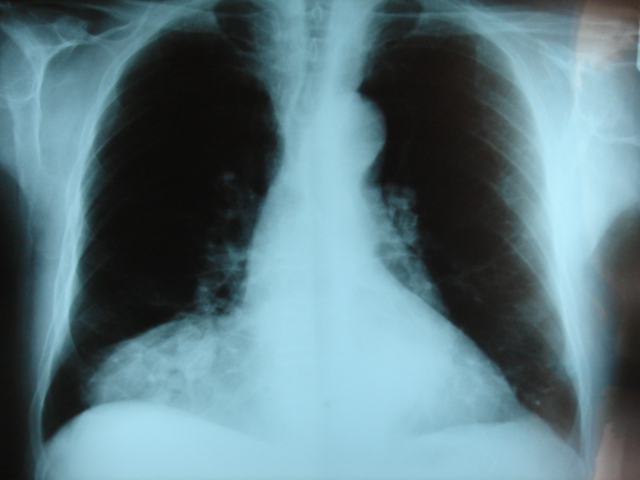Hernia
| Hernia | |
 | |
|---|---|
| Frontal chest X-ray showing a hernia of Morgagni | |
| ICD-10 | K40-K46 |
| ICD-9 | 550-553 |
| MedlinePlus | 000960 |
|
Hernia Microchapters |
|
Diagnosis |
|---|
|
Treatment |
|
Case Studies |
|
Hernia On the Web |
|
American Roentgen Ray Society Images of Hernia |
For the WikiPatient page for this topic, click here
Editor-In-Chief: C. Michael Gibson, M.S., M.D. [1] Associate Editor-In-Chief: Mohammed A. Sbeih, M.D. [2]
Overview
A hernia is a protrusion of a tissue, structure, or part of an organ through the muscular tissue or the membrane by which it is normally contained. The hernia has 3 parts: the orifice through which it herniates, the hernial sac, and its contents. The contents, usually portions of intestine or abdominal fatty tissue, are enclosed in the thin membrane that naturally lines the inside of the cavity. a Hernia has a potential risk of having its blood supply cut off (becoming strangulated), and the contents may become necrotic due to the lack of O2 supply.
A hernia may be likened to a failure in the sidewall of a pneumatic tire. The tire's inner tube behaves like the organ and the side wall like the body cavity wall providing the restraint. A weakness in the sidewall allows a bulge to develop, which can become a split, allowing the inner tube to protrude, and leading to the eventual failure of the tire.
Treatment
It is generally advisable to repair hernias in a timely fashion, in order to prevent complications such as organ dysfunction, gangrene, and multiple organ dysfunction syndrome. Most abdominal hernias can be surgically repaired, and recovery rarely requires long-term changes in lifestyle. Uncomplicated hernias are principally repaired by pushing back, or "reducing", the herniated tissue, and then mending the weakness in muscle tissue (an operation called herniorrhaphy). If complications have occurred, the surgeon will check the viability of the herniated organ, and resect it if necessary. Modern muscle reinforcement techniques involve synthetic materials (a mesh prosthesis) that avoid over-stretching of already weakened tissue (as in older, but still useful methods). The mesh is placed over the defect, and sometimes staples are used to keep the mesh in place. Increasingly, some repairs are performed through laparoscopes.
Many patients are managed through surgical daycare centers, and are able to return to work within a week or two, while heavy activities are prohibited for a longer period. Surgical complications have been estimated to be up to 10%, but most of them can be easily addressed. They include surgical site infections, nerve and blood vessel injuries, injury to nearby organs, and hernia recurrence.
Generally, the use of external devices to maintain reduction of the hernia without repairing the underlying defect (such as hernia trusses, trunks, belts, etc.), is not advised. Exceptions are uncomplicated incisional hernias that arise shortly after the operation (should only be operated after a few months), or inoperable patients.
It is essential that the hernia not be further irritated by carrying out strenuous labour.
External links
ca:Hèrnia de:Hernie ko:탈장 it:Ernia he:בקע nl:Hernia no:Brokk nn:brokk sr:Брух fi:Tyrä sv:Bråck